Requisition
 Requisition
Requisition
SPM documentation - January 5th 2010 – Written by Rémi Equoy - - Updated January 12th 2012
Introduction
Requisition enables user to generate a document which order a list of part number for a specific price to a customer.
Commonly, the Requisition is obtained from one (or many) quotations but SPM allows to create a new Requisition without having a quote.
Each Requisition's lines have an origin : Store, Vendor or Work Order.
Requisition allows booking for items coming from stores and advance booking for items coming from vendors . (see Booking engine for more information)
Main information
Shipping directive
Addresses, Contact and Forwarding agent tabs
PN tab
PN/Comment tab
Analytic tabs
Total
Main information

The Req # is defined automatically by using the document default format. You can select another the format or reuse an unused number by pushing the button "...".
The Customer can be typed or you can obtain a list of customer by double clicking. The customer have to be created before creating the Requisition.
The Outlet (Site) is one of the outlet your are granted to use.
The Date is the day date by default but you can change this one.
The Client's order receipt date is a date filled by the user representing the customer's order receipt date.
The Priority level can be choose among Routine, Expedite, Critical or A.O.G. .
The Customer's reference field enables user to type the customer order reference if there is one.
The Currency is normally defined by the customer (see customer form) but if the customer currency is not defined in the customer card or if you have a customer with multiple currency, you can change the quote's currency with this combo box.
The User is the first name and surname of the user who have created the quote.
The Folder enables to attach or to class the Requisition in a folder. (see General Data/Miscellaneous/folders to create a new folder)
The Status describe the state of the Requisition. Once approved, almost main information cannot be modified. (see Requisition statuses)
Shipping directive
Consult Shipping directive topic for more information.
Addresses, contact and Forwarding agent
Once the customer have been selected, the default contact, the default delivery address and the default invoicing address will be filled automatically except if the Requisition is created from a quote.
The user can change the contact list by adding (or deleting) contact coming from the customer ref card.
The Delivery address and the Invoicing address can be changed by selecting another site (if available in the customer ref card).
The forwarding agent will be the default one but the user will be allowed to select another one.
For more information see Customer topic.
PN tab
The PN tab list the PN which have been (or which will be) added to the order.
To add new items or to add items at the end of the list, right click on the upper left corner of the PN list.
Items or PN have to be added in two steps:
- Add or insert a PN base line.
- Define or add an origin (Stock or Vendor) from the PN Infos form.
If there is any available stock in the site's default store, the combined quantity and the origin will be automatically added.
If the Part Number describe Alternate Part Number (see Alternate), one sub line will be added for each alternate.
The following push-down menu are available :
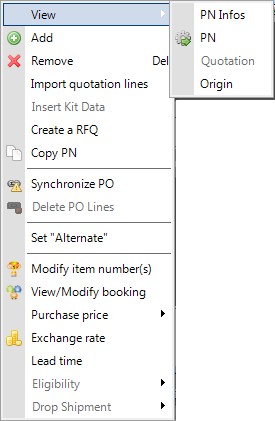
- View / PN Info : This command enables to open the PN infos form linked with this PN (See PN infos).
- View / PN : This command enables user to open the PN form (see Part Number)
- View / Quotation : This command opens the latest Quotation if the Requisition's line have been created from a Quotation (see Quotation to Requisition)
- View / Origin : This command opens the vendor if the origin is a vendor
- Add : This command opens the complete PN list and allows to search and add existing PN.
- Remove line : This command enables to remove one origin line or all lines of a part number if the right click have been done on a main line.
- Create RFQ : This command open a new Request For Quotation form with the select PN (see RFQ).
- Copy PN : This command copies the Part Number reference into the clipboard.
- Synchronize PO : This tool enables to update the linked PO when quantities have been modified (see Synchronize topic).
- Delete PO lines : This command will delete the PO line of the linked Purchase Order. To unlink a PO without deleting the PO line, untick in the Requisition the Selection check box.
- Modify item number : This tool enables to rename the item number of the selected line and potentially all following items of the Requisition :
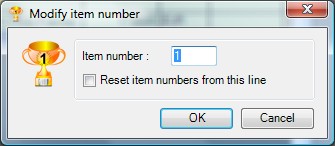
- View/Modify booking : This command enables to modify booking (see View/Modify booking).
- Purchase price : This command enables to work out the purchase price with the actual ordered or received purchase price (see Purchase price rule).
- Exchange rate : In SPM, each line transport a rate date. This feature enables to add items in a quotation without changing any exchange rate of old items. The tool enable to update the date for all line if it is the user choice (see Exchange rates):
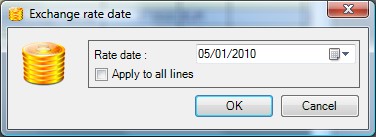
- Lead time: This command enables to modify Estimated lead time (see Lead time).
- Eligibility: This command enables to Set eligibility or to Remove eligibility of the goods booked by the line (see Shipping directive).
- Import quotation lines : This command enables to import items from a quotation, even if the Requisition is already crated from a Quotation. Items will be added at the end of the list of PN. (see also Quotation to Requisition)
PN columns :

- Selection (check box) : Only ticked lines are assumed to be valid and only those one will book parts when origin is a Stock.
- PN : This column unfolds Description, Type of alternate PN and the characteristic columns if the list of Part Number have characteristics.
- CD : Condition - This information comes from the line selected in the PN infos form (see PN infos).
- Selling UOM : This column show a combo box with the available Unit Of Measure of the PN (see UOM)
- Ord. Qty : Quantity of items ordered.
GREEN quantities are items shipped
BLACK quantities are items in progress
RED quantities are items unsynchronized
This column unfolds :

- Shipped : Shipped quantity - Sum of all quantities included in Delivery Notes which have at least one ship check box ticked.
- Ready to Ship : Ready to ship quantity - Sum of all quantities included in Delivery Notes with Ready to ship check box ticked.
- Prepared : Prepared quantity - Sum of all quantities included in Delivery Notes with Ready to ship check box not ticked.
- Received : Received quantity. This quantity is also the booked quantity (by the booking engine) for all items present in a store.
Note : The order status Closed/Settled can be reached only when all lines are fully shipped i.e. Shipped quantity = Ordered quantity.
- Origin : This column describe the origin of the item. It can be a Stock origin or a Vendor origin or a Work Order. Origin is selected in the PN infos form (see PN infos).
- Purchase/Renewal price : In the case of Stock origin, the parts may have many prices.

|
When the origin is a store, the last buy price price is displayed (non-PO RF items are discarded) a modification in a recent price list will update this price.
If no purchase price are found, the greater stock price will be used.
When the origin is a vendor, the purchase price, the MOQ, the MOV and the MLV are shown.
|
The purchase price may fluctuate. To avoid some mysterious result in the margin, the purchase price may be recomputed on demand:

|
If there is a PO linked, the PO's price with the PO's currency and the PO's UOM will be updated into the Requisition.
Else, If the PO is received or if the origin is a store, the purchase price will be obtained by work out the average purchase price of the booked or delivered items.
Moreover, the purchase UOM will be set into the sale UOM to clarify the read.
|
Moreover the Purchase/Renewal price may be modified by the user.
- Trading price : This price is only displayed in the Purchase price/Edit prices push down menu. This price enables to work out purchase department commission. (see Customer Invoice/Synthesis)
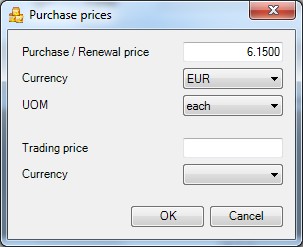
This dialog box also enables to modify Purchase currency and Purchase UOM.
- Sell unit price : It's a batch of tree columns with the sell unit price, the currency and the price expressed in the customer country's currency. This feature enables to define a sell price with a strong currency like euros or dollars and to show a converted price into the customer's currency. When unfolded, this column show the the Total selling price and the Total discounted selling price (see Discount below).
- Drop Shipment : This check box indicate goods to be drop shipped (see Drop Shipment feature). Only non saved line are tick able/untick able.
- Estimated Lead Time : This lead time is the estimate time delay to ship the parts from the site. No lead time means STOCK availabilities and the STOCK label will appears in the reports in place of the lead time. STOCK lead time means goods will be shipped before 0 to 4 days depending of priority level (see Processing time performances).
- Selling MOQ : Minimum Order Quantity. This column also unfolds minimum and maximum price break. Those value can be typed by the user if he want to define minimum order condition in his quote.
- Certif. : Certificate(s) or expected certificate(s) depending of the origin. (see Certificate)
- Incoterm : see Incoterm and/or General Data
- Mark-up : This percentage can be typed to define the sell unit price automatically from the purchase price. If the sell unit price is typed the mark-up will be computed automatically. When unfolded this column gives access to the agent commission which change the mark-up but not the sell unit price. Then the Discount column enable to compute a discount which will affect the Total discounted column.
- Quot. # : This column show the Quotation number if the line comes from a quote (see Quotation to Requisition).
Comment tab
The Comment tab enables to add a comment into each selected lines :
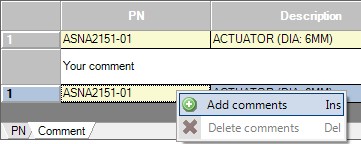
Furthermore this enable to select by ticking information to be included with the comment into the report :

 Use [CTRL] with the left click to automatically tick all check boxes of one column.
Use [CTRL] with the left click to automatically tick all check boxes of one column.
Analytic tabs

The analytic tabs enables to see linked document :
- Deliveries : This tab gives the list of Delivery Notes which have been made for this order.
- Generated PO : This tab gives the list of Purchase Order with at least on line linked with the order.
- Invoices : This tab gives the list of invoices which linked with this order.
Total
The Total enable to know the sum of all items, excluding and including taxes (if there is).

Fees may be added by using the button.
 See also - Requisition's status - PO Status - Consolidation - Compulsory fields -
See also - Requisition's status - PO Status - Consolidation - Compulsory fields -
Created with the Freeware Edition of HelpNDoc: Free CHM Help documentation generator
 Requisition
Requisition Requisition
Requisition








 Use [CTRL] with the left click to automatically tick all check boxes of one column.
Use [CTRL] with the left click to automatically tick all check boxes of one column.

 See also - Requisition's status - PO Status - Consolidation - Compulsory fields -
See also - Requisition's status - PO Status - Consolidation - Compulsory fields -